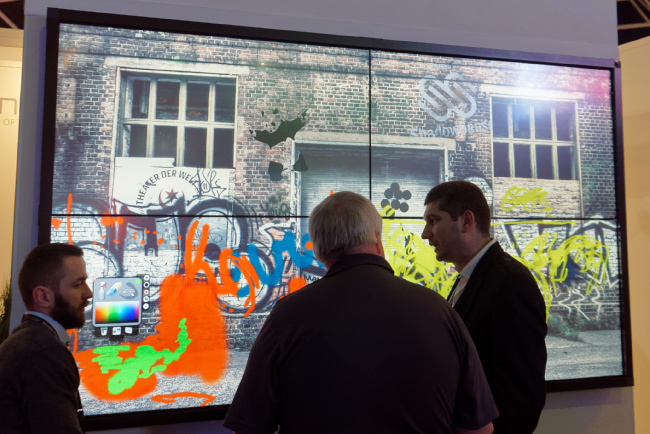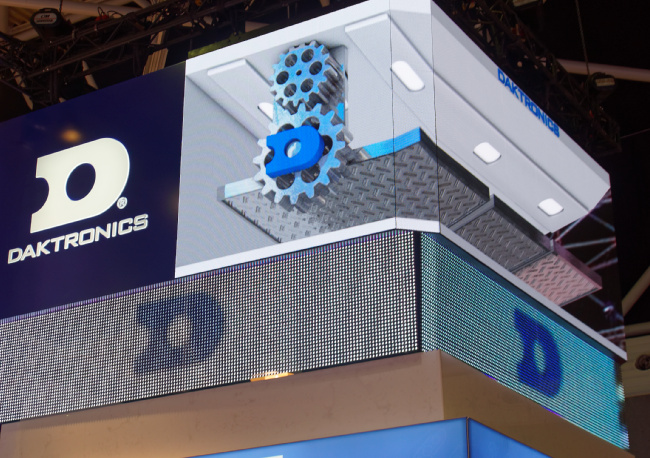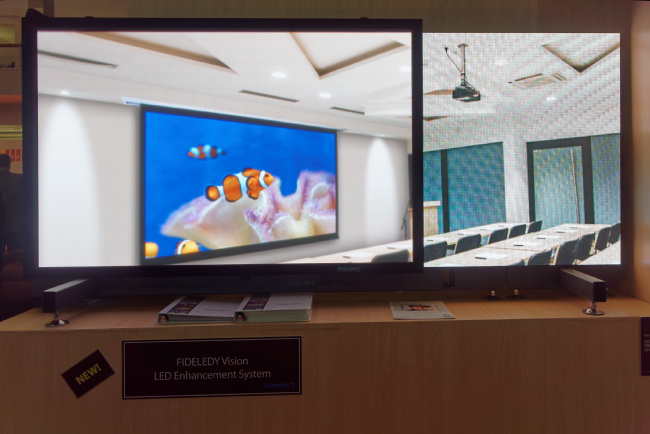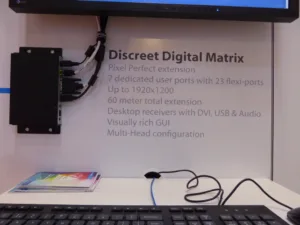Absen was showing a new 2.97mm rental LED display system that was being used with an infrared touch system and there was also a good looking 1.2mm indoor display which, as always with Absen, looked good and was well aligned. We noted that the front surface was warm, but LEDs often are!
The DDX (Discrete Digital Matrix) is a 30-port matrix from Adder Technologies. It can handle up to 23 sources or 29 users. A USB dongle (DisplayPort, DVI or VGA) plugs in to a PC and then connects to the DDX via a CAT-5 cable.
Three new products were on show by Advantech. The UTC-510 is a 10″ fanless panel PC (1920 x 1080, 250 cd/m², Bay Trail processor; VGA, component, USB (x2) and RJ45 ports). The DS-080 is a slim (19mm) digital signage player, with dual HDMI inputs and an Intel Core i5/Celeron processor. Finally was a 42″ prototype mirror glass display (UTC-542), which Advantech was gathering feedback on.
AG Neovo is developing its business by offering system solutions rather than just displays. The company is emphasising its experience and knowledge in a number of areas, including control rooms and security applications. It is also offering complete video wall solutions. Another area of interest for the firm is digital signage, where the company is working on content creation and hosting as well as display. At the show, AG Neovo was also showing a new generation of touch totems.
Arch of Belgium is an LED installer, doing a lot of work in the Middle East. The firm was celebrating a new project that it has just completed in Dubai, using 2,500 hexagon-shaped LED tiles; this mimics traditional Islamic design styles, which make heavy use of geometric shapes. Each tile holds 60 LEDs, and they are spaced along cords strung above a thoroughfare, providing shade in the day and light at night.
Aten has increased its focus on the AV market instead of KVM. The ‘over IP’ segment is growing for remote management, and the firm has developed a new tablet app for this application. Particularly interesting was a switcher/scaler that can transport DCI-4k video at 60Hz, and supports seamless switching, using HDMI ports (two-in, two-out). In Q2, Aten will release a 64GB media player, capable of sending content to up to 15 screens at 1920 x 1080 – 12 of which can be part of a video wall.
AV Stumpfl of Wallern, Austria, launched a new version of its 8K media server which can now deliver four streams of 4K uncompressed content at 60hz plus media overlays, text generation and show control on top. Wings Engine Raw now includes additional hardware upgrades such as four DisplayPort 1.2 video interfaces, professional multi-channel audio options and various input options including DVI, HDMI 2.0 and 3G-SDI. The engine uses a custom engineered RAID 10 sub-system. Content includes native picture sequences such as TGA or TIFF and instant PNG image format processing. The system processes and delivers video content at full 4:4:4 colour sampling.
Baanto told us at Infocomm that it was developing a new modular approach to its optics-based touch technology which is used by NEC among others. At ISE, the firm told us that “it’s a real product now” and has a number of advantages. The modular approach means that shipping is much easier than for completed frames and all configuration is automatic, with modules connecting together and negotiating to inform the system of the configuration. The between modules connector supports mechanical and electrical connections. The company has recently upgraded its software and it told us that NEC is supporting 4K in the US. The system can also support dual pens and will support 10 touches with the same performance as the current six touch system.
 Baanto is responding to competition from procap touch by supporting video walls. Image:Meko
Baanto is responding to competition from procap touch by supporting video walls. Image:Meko
We stopped for a Belgian beer with Barco and got into conversation with Barco Silex, which typically develops and licenses IP cores. At the show it was talking about its cores supporting the VC2 light codec to allow the transmission of video over ethernet. Silex had said at the end of January that it had validated its VC-2 (SMPTE 2042) codec core. The codec is based on patent-free technology originally developed by the BBC and delivers up to 4:1 compression that is visually lossless and has very low latency. Moving beyond just providing cores, Silex was showing at ISE a board that can be used to transmit video up to UltraHD/4K (30P) over a single 1Gb Ethernet cable. The board includes capture of the HDMI content and includes a full TCP/IP stack to allow transmission. The board is designed for OEMs that want to integrate these functions into their equipment. The next version will support 4K60 with 4:2:0 sub-sampling and Silex has JPEG 2000 compression technology, so could add this to the board. Pricing is on application.
 It looks as though the beer fumes affected the focus of the camera, but you can get the idea about the Barco Silex Video over ip boards. Image:Leffe
It looks as though the beer fumes affected the focus of the camera, but you can get the idea about the Barco Silex Video over ip boards. Image:Leffe
Having updated its software platform in December, Broadsign was extolling its benefits. The company redesigned the platform’s UI for the first time since it was launched, 10 years ago.
The main change to Calibre‘s products was the addition of analogue audio out and line out ports to its HQView UltraHD processor (HQView 670A).
Coleder is a Chinese company that was showing its LED products outside of China for the first time. It had 1.2mm and 1.5mm LED displays.
China’s Coretronic was showing a laser-phosphor projector (U28C) covering 115% of sRGB. It has a TV SoC and smart TV functionality. It is available in China now.
Crestron has launched a new ‘PinPoint’ app to work with USB Bluetooth beacons. One of these, plugged in to a Crestron wallplate, will tell the app where the user is located. The user then has several options, such as beginning a presentation with the AirMedia app or using a wayfinding tool to find a free meeting room that meets their requirements. The company also showed new room scheduling systems, with colour-coding to show whether a room was free.
Daktronics was in Hall 8 and was showing a 1.9mm pitch display. On the top of its booth was a specially rendered set of content around two sides of a display that had been designed with “false perspective” and rendered to make it look like a 3D space when viewed from a particular viewpoint – a bit like the projection mapped content that is often shown at exhibitions. The company was highlighting its architectural LEDs which are based on its “Pixelsticks” concept. The displays are designed to be used in buildings (there is an installation at Wembley Stadium in the UK, which is behind the glass on the outside of the venue). The Pixelsticks are said to resemble venetian blinds when viewed from the inside of a building.
 Daktronix had a “false perspective” 3D rendering on its LED display
Daktronix had a “false perspective” 3D rendering on its LED display
India’s Delta Displays was showing a 70″ rear-projection video wall cube, with 1920 x 1080 resolution; it is brighter than previous units, reaching 3,400 lumens with a laser light source. Delta’s Intellisense technology measures the internal components and compensates, such as speeding up the fans if heat rises. The cube has already been used in a control room installation in Germany.
Dolby was only showing audio products.
ELO had lots of news as the company has been moving towards touch systems based on Android rather than “dumb” displays and the company has a range of solutions from 10″ to 70″ that can use its new Android ELO Computer Module (Android ECM) add-on. The use of Android allows the “dragging and dropping” of apps to any screen including the touch screens using the firm’s EloView software and ELO said that this can be done securely. The ECM uses a Qualcomm SnapDragon CPU and slots into the back of the touch displays. ELO is also supporting Beacon technolog for location-based applications.
FlatFrog has made progress in the year since ISE last time and is now in a number of real shipping large format products which were being shown on the booth. (We recently reported on the win with VividTouch revealed at the BETT show). Products at ISE included a table and transparent display from MMT in Germany. The company was highlighting the high visual quality of its solution, which uses high quality glass and adds no materials other than glass into the optical stack.
Germany’s Friendlyway specialises in kiosks with add-on options. New this year are 32″ curved (vertically convex) and flat units. Customers can add modules such as a receipt printer, card reader, barcode scanner and presence sensor.
Green Hippo has continued to expand its Aviary range of products, with the Blue Bird: a lower-cost version of its Par4keet video wall controller, without the touch screen. The device supports up to UltraHD resolution and lacks transport controls. The company was also showing the Linx, a new rack-mounted splitter: it can take an UltraHD DisplayPort input and convert it into four independent, gen-locked 3G-SDI outputs.
Iiyama was in a positive mood as its sales have been going well both in general monitors and in touch. First we looked at the company’s procap monitors which are now available from 32″ to 55″ and is based on metal mesh technology. Iiyama is planning an UltraHD version of the 55″. The 55″ is also available with infrared touch and in that case, up to 20 touches are supported. The firm has a low cost 32″ touch solution that uses an AUO panel and it has been upgraded from 350 cd/m² to 500.
IntoPix is the developer of the Tico light compression technology which has been getting increasing support for applications in content contribution and professional distribution. The technology has now “passed ballot” as an RDD project for use in IP and SDI content contribution streams. There were a number of comments. IntoPix is the core technology provider, but these days there is input in direction from the Tico Alliance, which has 25 member companies. The company told us that there is still a lot of work going on to move to 4K60P in production, using JPEG 2000 (another technology area for IntoPix) and in the longer term, the codec will be moved to 8K. Originally, Tico was designed to work on 4:2:2 content, but now 4:4:4 has been supported and the codec is being looked at for digital cinema applications. Compression up to 4:1 is possible. The firm has cores that can support 8, 10 or 12 bit content and can be implemented on Altera or Xilinx FGPAs, without external DDR. As well as IP cores, IntoPix has now released a software-based encoder and decoder that runs under Windows and can support 4KP60.
Konka is well known as a major TV maker based in China, but was at the show to promote its B2B display business, Shenzhen Konka E-display Co.,Ltd. It is one of 14 subsidiaries of Konka and was showing interactive displays with 55″, 65″ and 70″ and FullHD as well as 84″ and 98″ UltraHD panels. The company was highlighting that it had Android integrated into the system and could use OPS to provide Windows, so that the unit on demonstration could be switched directly between the two operating systems. Konka calls this feature “EasySwitch”. The firm also has its own application software for interactivity which includes features to allow the annotation of videos which can be stored with the comments. As well as the interactive displays, the company also has monitors from 22″ to 65″+, totem units and both indoor and outdoor LEDs. Konka told us that it has a long history in LED with fixed and rental products available. Overseas sales are pretty well always under OEM brands and one of the big monitors looked distinctly like a BenQ to us!
A 3D LED video wall was being shown by Linsen Technology, of China. However, we were very unimpressed with the demonstration, which required users to wear 3D glasses; hardly fitting for digital signage! The first time we passed the stand, we saw the display covered in black marks, as if it had overheated.
Jon Sidwick, of distributor Maverick, told us that the company is now growing at 25% YoY. A large part of this is thanks to the massive success of the Surface Hub – which won’t even be shipped until April. According to Sidwick, back orders for the product are larger than all of Maverick’s European business eight years ago! The company is using its success to expand and open new offices in all of the Nordics, as well as Austria, Italy and the Netherlands.
At ISE 2015, Multitaction showed a prototype portable 3 x 1 video wall (ISE 2015 Roundup), which has now been finalised and is on sale. We were struck by the similarities to Microsoft’s Surface Hub, and Multitaction said that the announcement of the Hub – along with its late launch – has actually been very beneficial for the company! There is also a new version of the company’s software, called Showcase, which customers can use to change the appearance of elements of the display that could not previously be changed, such as the interface. It will be launched this year. Finally, Multitaction had a hybrid version of its iWall, which used both vertical displays and horizontal units.
Pallas has been showing its video wall bezel masking system for a number of years (we have been reporting on the company since 2013). The firm was showing its Generation 7 solution which fits on just two sides of the frame of a 55″ unit. The big change in G7 is that the image on the LEDs in the frame is generated based on data from the displays on both sides. We also thought that the distortion in brightness, when the frame is viewed from very oblique angles, was less than on previous versions.
 Pallas has improved the accuracy of its system, with data from panels on each side. Image: Meko
Pallas has improved the accuracy of its system, with data from panels on each side. Image: Meko
PQ Labs is a supplier of infrared touch technology for large format displays. At the show, the company admitted that it sees a threat to its traditional market for toucmh in large LCDs from other technologies, especially procap touch. To maintain its development, the firm is looking at larger display applications and at the show was demonstrating touch on a 220″ video wall display – with up to 500″ being possible.
The latest shipping technology (G5), which supports UltraHD panels, was being shown used with passive pens and also with active pens, which can be used to supply pressure data via bluetooth. In addition, PQ is developing its G6 technology which can actually detect bending and distortion in the glass of its touch display. The technology can recognise up to 1024 levels of pressure without the need for a pen, although a pen or stylus can also be used. Windows 10 can support pressure levels up to 0.5 with a finger and up to 1.0 with a pen using the PQ system which requires different hardware from current systems. PQ can also recognise an eraser, a Microsoft requirement.
LED display maker, Retop, told us that its is already shipping the 1.9mm 1,000 cd/m² LED that was on show. The firm was emphasising that all of its LED displays can be front-serviced, although the sample at the show was putting up a fight. The company claims to have the largest factory in China for LED manufacture and does its own chip packaging. As well as the indoor displays, the firm had a 15mm outdoor mesh display.
Ricoh was showing video conferencing and collaboration products, but no projectors.
Stewart Film Screen was showing a new use of one of its rear-projection diffusion screen materials. LED displays have sharp pixels with areas of black around them to enhance contrast and this can lead to moiré, especially in TV studios and other areas where a digital camera is being used to film the display. Stewart is calling the product Fideledy Vision and said that it is available to fits single displays from 40″ up to 90″. The screen diffuses the light from the LED and counters the moiré. Different pitches of LEDs can be accommodated by changing the distance between the screen and the LEDs to optimise for the focal length of the screen. The system is available now, but pricing is “on application” as it will depend on the framing, which tends to be customised.
 Stewart’s Fideledy R/P screen helps reduce moire in broadcast applications for LED. Image:Meko
Stewart’s Fideledy R/P screen helps reduce moire in broadcast applications for LED. Image:Meko
The 65″ TV that we saw at CES, from Stream TV Networks (Stream TV Continues Signage Push), is now on sale. It is designed for indoor use and costs €5,000. The tablet prototype and gaming monitor, also from CES, were also on display. Stream TV had relocated its stand to the front of Hall 8, and was getting a lot of attention – aided by the 3D video wall that was the talking point of the CES stand.
Although it was not present on the stand, Sunbrite TV (a maker of outdoor displays) said that it will soon launch an 84″ UltraHD model. It will have 800 cd/m² of brightneess, with RS232 and HDMI (x3) ports.
TVOne had a new 4k Multiviewer product (1T-MV-8474), which can show up to four windows on one display or video wall at the same time, via 16 different layouts. The product features DisplayPort (x2, UltraHD at 60fps), HDMI (x4, UltraHD at 30fps) and VGA inputs, as well as seven independent stereo analogue inputs, which can bee assigned and embedded into any of the video streams.
A new streaming media input module was also on show (CM-AVIP-IN-1USB-1ETH), which can be used for streaming and local playback with the Coriomaster. Up to two network streams can bring two network streams (up to 1920 x 1080 at 60fps) in to one slot (bit rates up to 20Mbps). It will be launched in September.
Zytronic was demonstrating its procap touch technology, which we were already familiar with. The company had an interesting video highlighting the robustness of the touch layer, which even worked under oil, ice or completely shattered front glass. Zytronic was going to show a new curved touch display, but decided to send it to Las Vegas for Digital Signage Expo instead.

